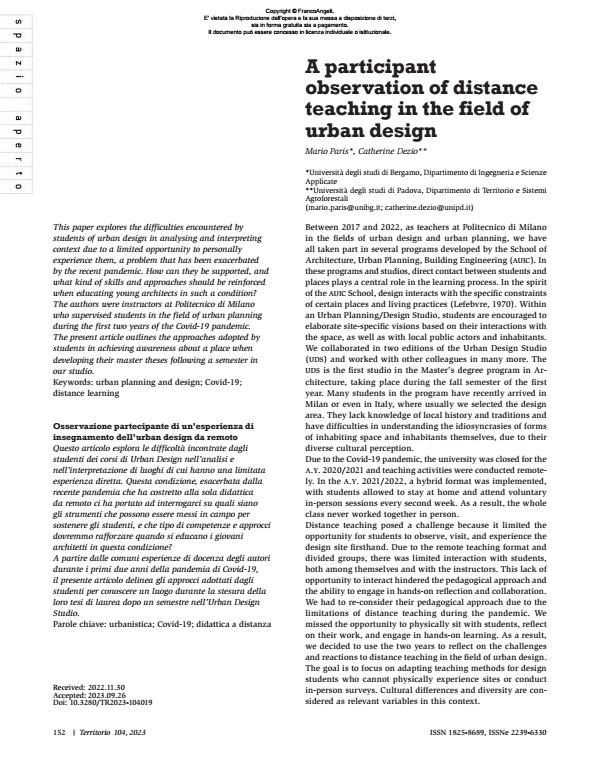A participant observation of distance teaching in the field of urban design
Titolo Rivista TERRITORIO
Autori/Curatori Mario Paris, Catherine Dezio
Anno di pubblicazione 2024 Fascicolo 2023/104
Lingua Inglese Numero pagine 12 P. 152-163 Dimensione file 491 KB
DOI 10.3280/TR2023-104019
Il DOI è il codice a barre della proprietà intellettuale: per saperne di più
clicca qui
Qui sotto puoi vedere in anteprima la prima pagina di questo articolo.
Se questo articolo ti interessa, lo puoi acquistare (e scaricare in formato pdf) seguendo le facili indicazioni per acquistare il download credit. Acquista Download Credits per scaricare questo Articolo in formato PDF

FrancoAngeli è membro della Publishers International Linking Association, Inc (PILA)associazione indipendente e non profit per facilitare (attraverso i servizi tecnologici implementati da CrossRef.org) l’accesso degli studiosi ai contenuti digitali nelle pubblicazioni professionali e scientifiche
This paper explores the difficulties encountered by students of urban design in analysing and interpreting context due to a limited opportunity to personally experience them, a problem that has been exacerbated by the recent pandemic. How can they be supported, and what kind of skills and approaches should be reinforced when educating young architects in such a condition? The authors were instructors at Politecnico di Milano who supervised students in the field of urban planning during the first two years of the Covid-19 pandemic. The present article outlines the approaches adopted by students in achieving awareness about a place when developing their master theses following a semester in our studio.
Questo articolo esplora le difficoltà incontrate dagli studenti dei corsi di Urban Design nell’analisi e nell’interpretazione di luoghi di cui hanno una limitata esperienza diretta. Questa condizione, esacerbata dalla recente pandemia che ha costretto alla sola didattica da remoto ci ha portato ad interrogarci su quali siano gli strumenti che possono essere messi in campo per sostenere gli studenti, e che tipo di competenze e approcci dovremmo rafforzare quando si educano i giovani architetti in questa condizione? A partire dalle comuni esperienze di docenza degli autori durante i primi due anni della pandemia di Covid-19, il presente articolo delinea gli approcci adottati dagli studenti per conoscere un luogo durante la stesura della loro tesi di laurea dopo un semestre nell’Urban Design Studio.
Parole chiave:urban planning and design; Covid-19; distance learning
- De las Rivas J.L., Paris M., Jiménz M., 2014, «Creating Figures: Why Reimagining Urban Structure Supports a Regenerative Urban Model». Architecture mps - Online publication.
- Albrechts L., Balducci A., Hillier J., 2017, eds., Situated practices of strategic planning: An international perspective. Abingdon: Routledge.
- Arefi M., Triantafillou M., 2005, «Reflections on the Pedagogy of Place in Planning and Urban Design». Journal of Planning Education and Research, 25, 1: 75-88. DOI: 10.1177/0739456X04270195
- Berger J., 1972, Ways of seeing. New York: Penguin Books.
- Bonsaksen T. et al., 2022, «Students’ Mental Health, Well-Being, and Loneliness during the Covid-19 Pandemic: A Cross-National Study». Healthcare, 10: 1-13.
- Ceccarelli P., 2019, «Introduction». In: Ceccarelli P. (ed.), Giancarlo De Carlo and ILAUD. A movable frontier. Milano: oami, 7-12.
- De las Rivas J.L., 1992, El espacio como lugar. Valladolid: Universidad de Valladolid.
- De Munck V.C., Sobo E.J., 1998, eds., Using methods in the field: a practical introduction and casebook. Lanham: AltaMira Press.
- Erlandson D.A., Harris E.L., Skipper B.L., Allen S.D., 1993, Doing naturalistic inquiry: A guide to methods. New York: Sage.
- Goldschmidt G., 1988, «Interpretation: its role in architectural designing». Design Studies, 9, 4: 235-245. DOI: 10.1016/0142-694X(88)90009-9
- Gourlay L., 2021, «There Is No Virtual Learning: The Materiality of Digital Education». Journal of New Approaches in Educational Re- search, 10, 1: 57-66.
- Lefebvre H., 1970, La révolution urbaine. Paris: Gallimard.
- Marshall C., Rossman G.B., 1989, Designing qualitative research. New York: Sage.
- Norberg-Schulz Ch., 1980, Genius loci: Towards a phenomenology of architecture. Milano: Rizzoli.
- Olesen K., 2018, «Teaching planning theory as planner roles in urban planning education». Higher Education Pedagogies, 3, 1: 23-39. DOI: 10.1080/23752696.2018.1425098
- Paris M., 2019, «Teaching the Contemporary City Abroad». Territorio, 88: 65-66. DOI: 10.3280/TR2019-088009
- Roig-Vila R., Rojas-Viteri J., Lascano-Herrera N.A., 2022, «Análisis del uso de Moodle desde la perspectiva del modelo TAM en tiempos de pandemia». RIITE Revista Interuniversitaria de Investigación en Tec- nología Educativa, 12: 95-112.
- Roig-Vila R., Urrea-Solano M., Merma-Molina G., 2021, «La comu- nicación en el aula universitaria en el contexto del COVID-19 a partir de la videoconferencia con Google Meet». RIED. Revista Iberoamericana de Educación a Distancia, 24, 1: 197-220.
- Şalgamcıoğlu B.K., Genç I., 2021, «The Ones Who Have Never Been
- Physically in a Studio: Myths and Hacks of First Year Basic Design Students in the Pandemic». Design and Technology Education: An International Journal, 26, 4: 130-143.
- Schön D.A., 1985, The Design Studio: An Exploration of Its Traditions and Potential. London: RIBA Publications.
- Verloo N., Bertolini L., 2020, «Introduction». In: Verloo N., Bertolini L.(eds.), Seeing the city. Amsterdam: Amsterdam University Press, 12-21.
- Werner A.M. et al., 2021, «The impact of lockdown stress and loneliness during the Covid-19 pandemic on mental health among university students in Germany». Sci Rep, 11.
Mario Paris, Catherine Dezio, A participant observation of distance teaching in the field of urban design in "TERRITORIO" 104/2023, pp 152-163, DOI: 10.3280/TR2023-104019